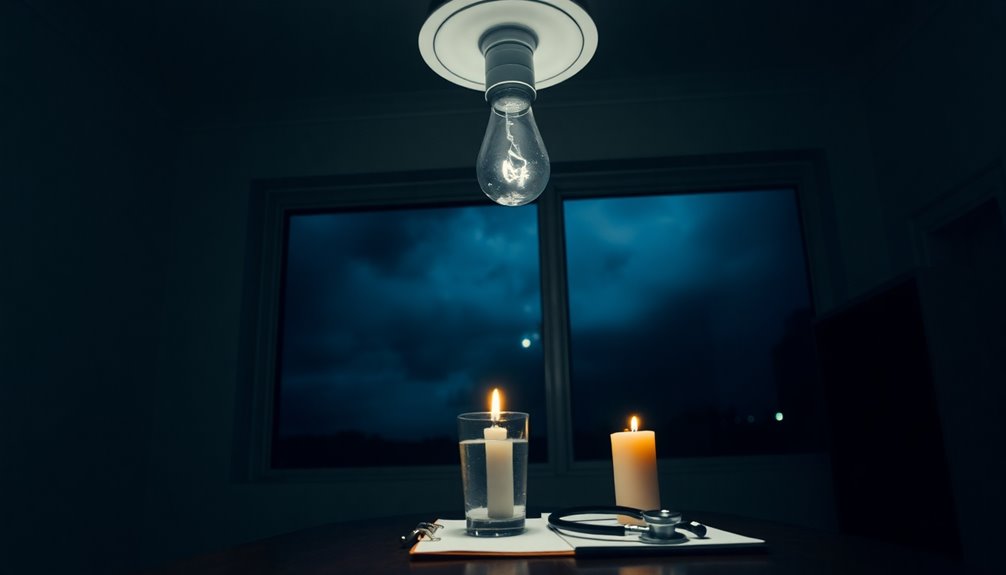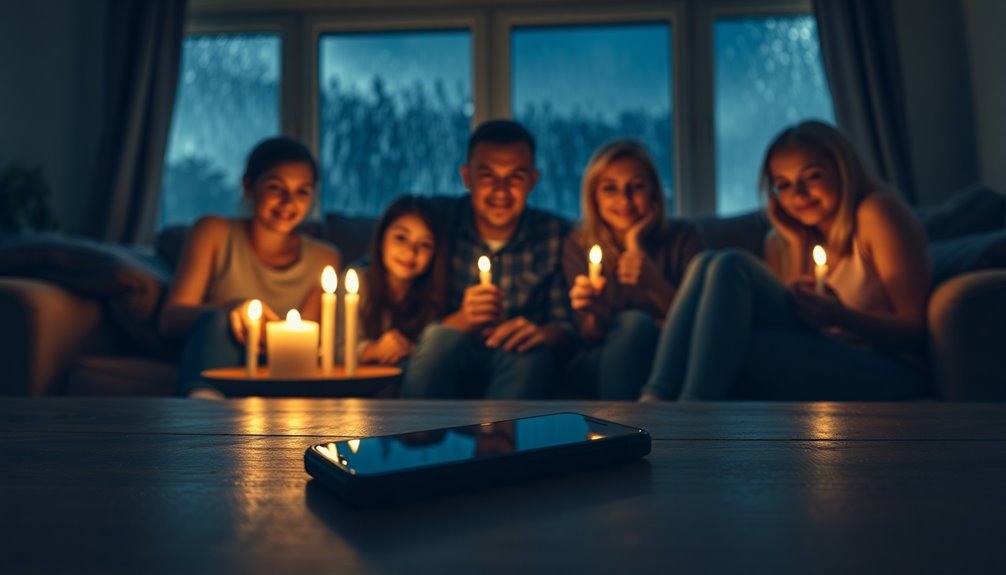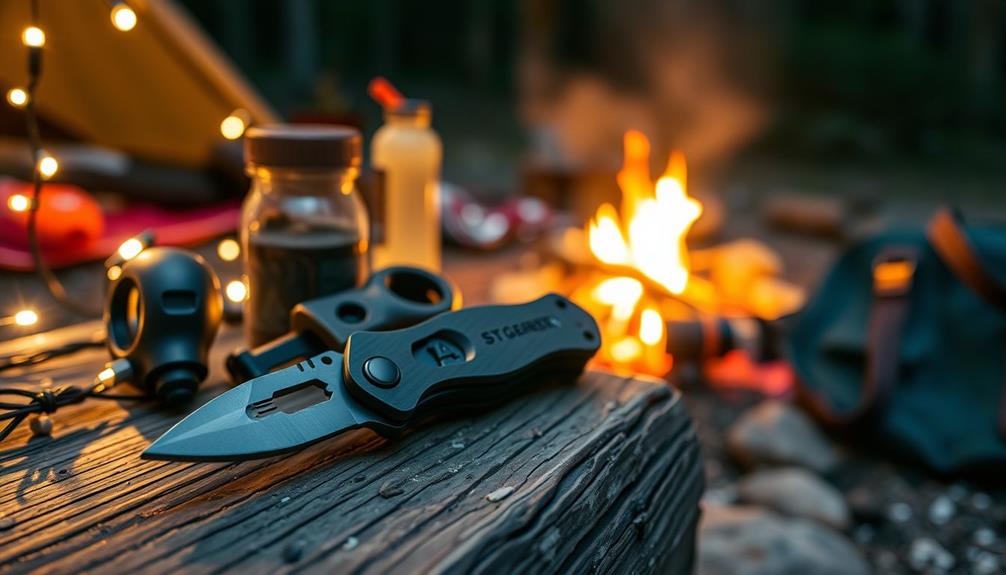During a power outage, the one thing you must avoid is using candles for light. Candles pose a significant fire hazard, especially in homes where flammable materials are nearby. Instead, opt for flashlights or glow sticks, which are much safer options. It's vital to keep the refrigerator and freezer closed to maintain food safety and to unplug any electronic devices to prevent overload when power returns. Staying informed and prepared helps you manage the situation better. Curious to know what else you can do to stay safe and comfortable during an outage? There's more essential advice to take into account.
Key Takeaways
- Avoid opening refrigerator and freezer doors frequently to maintain cold temperatures and preserve food safety during outages.
- Do not use gas ovens or portable heaters indoors, as they can lead to carbon monoxide poisoning.
- Never use candles for light; opt for flashlights or glow sticks to prevent fire hazards.
- Refrain from connecting generators indoors, as this increases the risk of carbon monoxide buildup.
- Avoid neglecting medical needs; ensure backup power for life-support devices and stay connected with healthcare providers.
Preparing for a Power Outage

Preparing for a power outage starts with building a solid emergency kit. You should include at least one gallon of water per person per day, enough for three days if you need to evacuate and two weeks for staying home. Stock non-perishable foods that are easy to prepare, aiming for a three-day supply for evacuation and two weeks for home use. Don't forget to add flashlights, headlamps, and extra batteries to your kit. It's also wise to consider having an air purifier on hand to improve indoor air quality during extended outages, especially if doors and windows are kept closed.
Incorporate a battery-powered or hand-crank radio, along with a clock or watch to keep track of time. A first aid kit and any essential medical items are also vital. Creating an outage kit ensures you have the necessary supplies to maintain comfort and safety during an outage.
When planning for food and water, use perishables from your refrigerator first and keep the doors closed to maintain temperature. If the outage lasts, consider transferring food to iced coolers. Remember to account for feeding and watering your pets, especially if your well pumps are affected. Store food in a dry, cool spot, ensuring it's covered at all times.
Essential Safety Measures

During a power outage, it's crucial to prioritize essential safety measures to protect yourself and your home. First, opt for flashlights or glow sticks instead of candles to avoid fire hazards. Never use gas ovens, ranges, or portable heaters indoors due to the risk of carbon monoxide poisoning. Keep matches and candles stored away from flammable materials and in water-resistant packages.
Unplug all electric appliances to prevent circuit overloads when power returns. Turn off major appliances that were running during the outage to avoid unexpected startups. Confirm that light switches are turned off as well, even in the dark. Additionally, it's important to maintain ventilation when using kerosene heaters or gas lanterns indoors to ensure safety.
To maintain food safety, keep refrigerator and freezer doors closed; a full freezer can keep food frozen for up to 48 hours. If needed, use an ice chest to keep perishables cold. Discard any food that feels warm, especially meat, seafood, and dairy.
Stay vigilant about your surroundings. Keep away from downed power lines and report them immediately. Conserve water during the outage and confirm you have enough drinking water on hand. Stay informed with a battery-powered radio and check on family members or neighbors if it's safe to do so.
Generator Usage Guidelines

When you're using a generator, it's essential to place it outdoors in a well-ventilated area to avoid dangerous carbon monoxide buildup. Make sure it's at least 20 feet away from your home to keep CO from seeping inside. To enhance safety further, install carbon monoxide detectors in your home to alert you of any hazardous levels. Additionally, ensure that the generator is properly grounded to prevent overloading for optimal safety during operation.
Outdoor Generator Placement
Choosing the right outdoor generator placement is essential for safe and efficient operation. You need to take into account various factors to guarantee your generator works effectively while minimizing risks. Here are some key guidelines:
- Place the generator at least 5 feet away from doors, windows, and vents.
- Maintain a clearance of 1.5 feet from buildings, with a manufacturer's recommendation of 5 feet.
- Guarantee a minimum of 3 feet of clearance from shrubbery, decking, and fences.
- Avoid locations prone to snowdrifts or flooding, and make sure it's on level ground.
- Position the exhaust facing away from your home to prevent harmful fumes.
Additionally, it's crucial to consider local regulations that may influence your placement options.
Following these guidelines not only protects your property but also complies with local codes and manufacturer recommendations. Always keep in mind that proper placement can markedly affect your generator's performance and safety. By adhering to these standards, you'll enjoy peace of mind during power outages, knowing your generator is positioned correctly for reliable use.
Carbon Monoxide Detectors
After ensuring your outdoor generator is properly placed, it's important to address the risks associated with carbon monoxide (CO) emissions. Carbon monoxide detectors are imperative for monitoring CO levels, especially when you're using portable generators. These detectors alert you when CO concentrations reach unsafe levels, providing an important safety net.
Install battery-operated CO alarms inside your home, following the manufacturer's guidelines for placement. Regularly test these alarms and replace batteries as needed. Even with your generator outside, CO can still drift indoors due to wind changes, making these detectors essential. Additionally, most fatalities occur during weather-related power outages, highlighting the critical need for detection measures. In fact, using a generator indoors can lead to serious risks of CO poisoning, making safety precautions even more vital. It's crucial to consider that the average cost of a home security system can help protect against other hazards while ensuring your safety. Moreover, proper maintenance practices for your generator can help minimize risks associated with CO emissions.
Some generators are equipped with built-in CO sensors that automatically shut off the unit when CO levels exceed safe limits. However, don't rely solely on these features; generators should never be used indoors, regardless of ventilation.
Be aware of CO poisoning symptoms—headaches, fatigue, and confusion can escalate quickly. If you experience these, get fresh air immediately and seek medical attention. CO poisoning can mimic other illnesses, so recognizing these symptoms is significant. Keep emergency contact information handy in case of a CO incident, ensuring you're prepared to act swiftly.
Food Storage Tips

During a power outage, keeping your refrigerator and freezer doors closed is essential to maintain safe temperatures for your food. If the outage lasts longer, using coolers with ice can help preserve perishables. Always be prepared to discard any food that's unsafe to eat once temperatures rise above the danger zone. Having ice on hand can further extend the preservation of your food during these challenging times.
Maintain Refrigerator Temperature
To maintain the cold temperature in your refrigerator during a power outage, keep the doors closed as much as possible. This simple action helps preserve your food by keeping the cold air trapped inside. Remember, a closed refrigerator can keep food safely cold for about four hours. Here are some tips to maximize food safety during an outage:
- Use appliance thermometers to monitor your refrigerator (should be at 40°F/4°C or below) and freezer (0°F/-18°C or lower). Additionally, try to include frozen foods in your planning, as they can help keep the overall temperature lower.
- Freeze containers of water or gel packs in advance to help lower temperatures during an outage.
- Group refrigerated and frozen foods together to help them stay colder longer.
- Avoid opening the refrigerator doors frequently, as this can quickly raise the temperature inside.
- Check for signs of spoilage regularly, especially for perishable items like meat and dairy. Additionally, keeping doors closed maximizes cold air retention, allowing your food to remain safe for a longer period during an outage.
Use Coolers Effectively
When a power outage strikes, having coolers ready can be a lifesaver for preserving your food. If the power's out for more than four hours, pack your refrigerated items like milk, meats, fish, poultry, eggs, and leftovers into coolers surrounded by ice. Make certain your cooler is easily accessible and prepped before the outage hits.
To keep everything cold, group perishable foods together and use ice or frozen gel packs. Arrange food in a way that allows good air circulation, and remember to keep the cooler closed as much as possible to maintain the cold temperature. If you expect a long outage, consider using dry ice or block ice, which can keep a fully stocked cooler cold for about two days. Refrigerated foods become unsafe after four hours without cold source, so it's crucial to act quickly.
Check the cooler's temperature regularly to confirm it's at or below 40°F. Avoid placing coolers outside; fluctuating temperatures and animal contact can compromise your food safety. If you do use dry ice, make sure the cooler is well-ventilated to prevent carbon dioxide buildup. By following these tips, you'll greatly increase your chances of keeping your food safe during a power outage.
Discard Unsafe Food
Even with effective use of coolers, some food may still become unsafe during a power outage. It's essential to know when to discard food to prevent foodborne illnesses. Here are key guidelines to follow:
- Discard perishable foods in the refrigerator after 4 hours without power, including meat, poultry, fish, eggs, dairy, leftovers, and cut fruits and vegetables.
- Check frozen foods: toss items from a half-full freezer after 24 hours and from a full freezer after 48 hours. If they still have ice crystals or are at 40°F (4°C) or below, they can be refrozen.
- Identify spoiled food: any food with unusual odor, color, or texture should be discarded. Additionally, ensure proper temperature control for medications that may also be affected during a power outage.
- Inspect packaging for damage like dents, rust, or holes that could indicate contamination.
- Monitor temperatures: keep refrigerator and freezer doors closed as much as possible, and use a thermometer to verify safety.
When in doubt, remember the golden rule: if you're uncertain about the safety of any food, it's best to throw it out. Your health is worth more than any wasted food.
Medical Considerations

During a power outage, it's vital to assess the medical needs of those around you. Identify individuals who rely on life-support equipment or have chronic health conditions that depend on electricity. Prioritize assistance based on the severity of their medical conditions and the criticality of their devices.
| Medical Device | Power Requirement | Action Needed |
|---|---|---|
| Ventilator | Continuous power | Guarantee backup power source |
| Oxygen concentrator | Continuous power | Charge backup batteries |
| LVAD (Left Ventricular Assist Device) | Continuous power | Check generator availability |
Familiarize yourself with the battery life of each device and keep backup batteries charged. If possible, explore utility company programs that offer battery power banks. Communication is key; collaborate with community partners to maintain access to healthcare services. Additionally, ensure that your facility has a plan to relocate critical patients to areas with emergency power during outages.
Be mindful that power outages can lead to health risks, including increased hospitalizations. Make sure patients with respiratory conditions have alternative treatments available. Finally, register with utility providers to receive notifications about power issues affecting medical equipment. Keep yourself and others safe by staying informed and prepared.
Actions During a Power Outage

Power outages can disrupt your daily routine, but knowing how to respond effectively can make all the difference. Here are some essential actions you should take during a power outage:
- Stay safe: Keep away from downed power lines and treat them as live. Stay at least 35 feet away from any fallen lines, and call 9-1-1 to report them.
- Prevent fire hazards: Avoid using candles or open flames. Instead, use flashlights to light your space. Consider having HEPA filtration air purifiers on hand to improve indoor air quality during extended outages.
- Protect your appliances: Unplug electronics to prevent damage when power is restored. Keep refrigerator and freezer doors closed to maintain cool temperatures.
- Manage food and water: Stock up on non-perishable food and fill containers with water for sanitation. If you have ice packs, use them to keep food safe.
- Stay connected: Keep your mobile devices charged and have a corded phone handy. Sign up for alert systems to receive updates about the outage.
Post-Outage Recovery Steps

Once the power's back on, it's crucial to jump right into post-outage recovery steps to guarantee a smooth shift back to normalcy. Start by evaluating any personal injuries and provide medical attention if needed. Next, examine physical damages to your infrastructure and equipment, and document everything for potential reimbursement.
Once you've handled injuries and damages, prioritize restoring critical systems. Create a step-by-step plan for restarting operations, confirming all safety protocols are followed. Test systems thoroughly before fully resuming operations to avoid further issues. Additionally, consider that 44% of outages are caused by environmental factors, so ensure your plan includes contingencies for these scenarios.
Don't forget about your backup power sources. Regularly inspect and service your generators, and establish a maintenance schedule to keep them in prime condition for future outages.
Reconnect and test all your electrical devices, resetting clocks and settings as necessary. Restore your communication systems and IT infrastructure to confirm you're fully operational. Finally, update your status with relevant regulatory agencies. Conduct an after-action discussion with your team to identify improvements for future outages. Following these steps will not only help you recover but also prepare you for any disruptions down the line.
Frequently Asked Questions
How Long Can Food Last Without Power in the Refrigerator?
Food in your refrigerator can last about four hours without power if you keep the doors closed. After that, the temperature rises, and perishable items like meat, dairy, and leftovers can spoil. If the power's out longer, group your refrigerated foods together to help maintain a colder temperature. Always check the temperature when power returns; if it's above 40°F for more than two hours, you should discard those items for safety.
What Are the Signs of Carbon Monoxide Poisoning?
Imagine breathing in a silent killer. Carbon monoxide poisoning can sneak up on you, presenting symptoms like headaches, dizziness, and weakness. You might feel nauseous or notice a rapid heartbeat. As it worsens, shortness of breath and confusion can set in, leading to severe consequences like seizures or loss of consciousness. If you experience these signs, you've got to act fast—get fresh air and seek medical help immediately. Your life depends on it.
Can I Use My Gas Stove for Heating During an Outage?
You shouldn't use your gas stove for heating during an outage. Gas stoves produce carbon monoxide, a dangerous and colorless gas that can lead to poisoning in enclosed spaces. Additionally, the open flame poses a significant fire risk, especially indoors. It's essential to follow safety guidelines and only use heating appliances designed for indoor use. Instead, consider safe alternatives like battery-operated heaters or electric heaters in well-ventilated areas. Stay safe!
How Do I Safely Store Medications Without Refrigeration?
How can you keep your medications safe without refrigeration? Start by using ice packs or cooling bricks to maintain a cool temperature. If the outage lasts longer, consider a portable insulin cooler, ideally one that runs on a car battery or solar power. Always monitor the temperature to avoid freezing. Remember to keep the medications insulated from direct contact with ice packs, ensuring they remain effective during the outage.
What Should I Do if My Generator Won't Start?
If your generator won't start, first check the fuel level and guarantee you're using high-quality fuel. Inspect the battery for charge and clean connections. Look for oil levels; add if necessary. Verify the starter motor and control panel are functioning properly. If you're using a manual transfer switch, make certain it's activated. Finally, confirm that the choke lever is in the correct position and that no devices are plugged in during startup.
Conclusion
In the face of a power outage, remember that like Odysseus maneuvering treacherous seas, your preparation can guide you safely home. Avoid the temptation to open your fridge or freezer, as every second counts in preserving your food. Stay calm, follow safety measures, and rely on your plans. Once the lights flicker back to life, you’ll be ready to embrace normalcy again. With a little foresight, you can weather any storm and emerge unscathed. Remember to stock up on non-perishable foods, such as canned goods and dried fruits, to see you through the blackout. Keep a flashlight and spare batteries handy, and consider investing in a generator for extended outages. These emergency preparedness hacks can make all the difference in staying safe and comfortable during a power outage.










